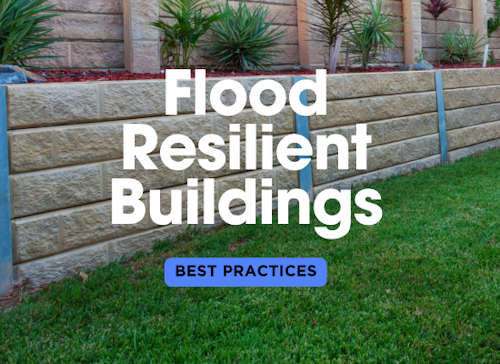Designing flood-resilient buildings is crucial for protecting both lives and property, especially as flood risks continue to rise due to climate change and increasing urbanization. Whether you’re constructing new buildings or retrofitting existing ones, there are key steps that can minimize flood damage. From material selection to landscape planning, the following table outlines practical and effective best practices to ensure your building can withstand flood events.
| FloodMart: Best Practices for Designing Flood-Resilient Buildings | |
| Step | Description |
| Site Assessment | Conduct a thorough flood risk assessment to determine the floodplain, local drainage patterns, and potential water sources. Use flood maps and consider both historical data and future projections. |
| Elevated Structures | Design buildings with elevated foundations, such as stilts or raised platforms, to keep living spaces above projected flood levels. This is particularly effective in coastal or low-lying areas. |
| Water-Resistant Materials | Use flood-resistant materials for walls, floors, and insulation, such as concrete, tile, and closed-cell foam. These materials can withstand water exposure without significant damage. |
| Flood Vents | Install flood vents in foundation walls to allow floodwaters to pass through, reducing pressure on the structure and minimizing the risk of collapse. |
| Waterproof Electrical Systems | Position electrical outlets, wiring, and appliances above expected flood levels, and consider using waterproof or water-resistant systems for added protection. |
| Drainage and Landscaping | Incorporate sloped landscaping, retention ponds, and permeable surfaces around the building to improve drainage and reduce the risk of water pooling near the foundation. |
| Backflow Prevention | Install backflow valves in plumbing systems to prevent sewage and floodwaters from entering the building through drainpipes. |
| Flood Barriers | Use deployable flood barriers or floodproof walls around the perimeter of the building to create a physical barrier against rising water. |
| Emergency Exits and Evacuation Plans | Ensure that the building design includes accessible emergency exits and well-thought-out evacuation routes in case of a flood event. This is especially important for multi-story buildings. |
| Regular Maintenance | Schedule regular inspections and maintenance for drainage systems, flood barriers, and building materials to ensure long-term resilience. |
Insider Strategies
💡 1. Conduct a Site-Specific Flood Risk Analysis
- Why It Matters: Knowing the exact flood risk for your location allows you to make informed decisions about design and material use.
- Insider Tip: Go beyond basic flood maps—use local hydrology experts to gather granular data about water flow and seasonal variations.
- Pro Tip: Look into predictive flood models that account for climate change projections.
- Key Resources: FEMA Flood Maps, Local Hydrologists, Predictive Modeling Tools
🏗️ 2. Elevate the Foundation—But with a Twist
- Why It Matters: Elevating a building reduces direct contact with floodwaters, safeguarding both structure and contents.
- Insider Tip: Consider a combination of stilts and floating foundations in extremely flood-prone areas. Floating foundations can rise with floodwaters.
- Pro Tip: Use FEMA’s base flood elevation (BFE) as your starting point, then add extra height for future-proofing.
- Key Resources: FEMA BFE Guidelines, Engineered Floating Foundations
🧱 3. Opt for Water-Resistant Finishes Throughout
- Why It Matters: Water-resistant materials save time and money on post-flood repairs.
- Insider Tip: Install flood-resistant insulation such as closed-cell foam, and pair it with water-impermeable wall finishes like ceramic tiles or water-resistant drywall.
- Pro Tip: Consider using sealed concrete floors in high-risk areas to minimize flood damage.
- Key Resources: Flood-Resistant Building Materials Guide, Moisture-Resistant Insulation Options
🌊 4. Install Smart Drainage Solutions
- Why It Matters: Proper drainage helps keep floodwaters from pooling around your building, reducing pressure on your foundation.
- Insider Tip: Use a combination of sloped landscaping, French drains, and stormwater retention systems. Consider installing smart drains that activate pumps when water levels rise.
- Pro Tip: Use pervious concrete or permeable pavers to improve drainage around your building.
- Key Resources: Smart Drainage Systems, Landscape Architect for Flood-Resilient Design
🚪 5. Elevate Critical Systems and Access Points
- Why It Matters: Electrical systems, HVAC, and emergency exits are vital to keep operational during a flood.
- Insider Tip: Place electrical panels, water heaters, and HVAC systems on raised platforms or the second floor. Ensure emergency exits are easy to access in the event of flooding.
- Pro Tip: Waterproof any equipment left on lower levels and ensure that emergency exit doors have water-tight seals.
- Key Resources: Waterproofing Electrical Systems, Elevated HVAC Solutions
🛠️ 6. Design Multi-Function Flood Barriers
- Why It Matters: Flood barriers provide a first line of defense and can also be aesthetically integrated into your design.
- Insider Tip: Install deployable barriers that double as outdoor seating or architectural features. These can be quickly activated during a flood while serving dual purposes when not in use.
- Pro Tip: Combine flood barriers with reinforced perimeter walls for added security.
- Key Resources: Flood Barrier Design Companies, Multipurpose Urban Flood Defense
🏞️ 7. Create Absorptive Landscaping to Slow Floodwaters
- Why It Matters: Slowing down water runoff helps reduce the overall volume of floodwater that reaches your building.
- Insider Tip: Plant native species that absorb water efficiently and design rain gardens around the property to act as natural water-absorbing basins.
- Pro Tip: Use permeable pavers and rainwater harvesting systems to capture and redirect water for reuse.
- Key Resources: Rain Garden Design Manuals, Native Water-Absorbing Plants
🏠 8. Invest in Smart Flood Detection and Response Systems
- Why It Matters: Early flood detection allows for rapid response, minimizing damage to your building.
- Insider Tip: Install smart sensors that detect rising water levels and automatically trigger pumps, flood barriers, or alerts to the building owner or residents.
- Pro Tip: Integrate flood detection systems with your building’s smart home or security system for seamless operation.
- Key Resources: Smart Flood Sensors, Home Automation Flood Systems
🏡 9. Use Floating Furniture and Equipment
- Why It Matters: Floods can cause significant damage to furniture and equipment. Designing for buoyancy can help mitigate losses.
- Insider Tip: Opt for lightweight, floating furniture and equipment that will rise with the floodwater instead of getting damaged or trapped.
- Pro Tip: Look for modular designs that are easy to move and elevate before a flood.
- Key Resources: Flood-Resistant Furniture Suppliers, Buoyant Equipment Solutions
🔑 10. Install Backflow Valves for All Plumbing Systems
- Why It Matters: Floodwater can cause sewage and stormwater to back up into your building, leading to extensive damage.
- Insider Tip: Install backflow prevention valves in all floor drains, toilets, and sinks to stop floodwater from entering through your plumbing.
- Pro Tip: Choose automatic backflow valves that activate without manual intervention, especially in high-risk flood zones.
- Key Resources: Backflow Valve Installation Guides, Plumbing Solutions for Flood Zones
📦 11. Design Elevated Storage for Valuables and Equipment
- Why It Matters: Storing essential items and equipment at ground level is a recipe for disaster during a flood.
- Insider Tip: Build elevated storage spaces such as overhead shelving or second-floor compartments specifically for important documents, electronics, and other valuables.
- Pro Tip: Consider vertical storage units with waterproof sealing for additional protection.
- Key Resources: Flood-Proof Storage Solutions, Water-Resistant Shelving Suppliers
🛠️ 12. Make Use of Flood Insurance Incentives
- Why It Matters: Many insurance companies offer premium reductions or rebates for flood-resistant building features.
- Insider Tip: Check with your insurance provider for incentives on flood resilience upgrades like flood vents, elevated foundations, and backflow prevention systems.
- Pro Tip: Implement features that qualify for flood mitigation credits and save on insurance premiums long-term.
- Key Resources: Flood Insurance Premium Reduction Programs, FEMA Flood Mitigation Assistance
Stay Focused
Flood-resilient design is not just about building stronger structures but also about making thoughtful choices at every stage of the process. After identifying the site’s specific flood risks through a thorough Site Assessment, architects and builders can incorporate a variety of strategies to keep water at bay. For example, elevating the structure on stilts or platforms is one of the most effective ways to protect a building from floodwaters. This is especially relevant in areas where rising sea levels or heavy rainfall pose significant threats.
Material selection is another critical factor. Choosing Water-Resistant Materials such as concrete or closed-cell foam ensures that if water does enter the building, the damage will be minimal, and the recovery process will be smoother. Additionally, using Flood Vents helps to equalize water pressure, reducing the risk of structural damage by allowing water to pass through without building up pressure against the walls.
Don’t overlook the smaller details like the placement of Waterproof Electrical Systems. Simply raising outlets and wiring above anticipated flood levels can save significant costs in repairs and avoid the risk of electrical fires during or after a flood.
One of the more underrated aspects of flood-resilient design is effective Drainage and Landscaping. By designing the surrounding landscape to guide water away from the foundation and using permeable materials, you can prevent water from pooling around the building, which could otherwise weaken the foundation over time. Coupled with Backflow Prevention in plumbing, this helps to ensure water only flows out of the building, not in.
Flood Barriers and deployable solutions can offer an extra layer of protection for those unpredictable flood events. These barriers can be quickly deployed in anticipation of rising waters and can make a significant difference in minimizing flood damage.
The importance of Emergency Exits and Evacuation Plans should not be underestimated, especially in multi-story buildings or complexes. Having clear, accessible evacuation routes can save lives when time is of the essence.
Finally, consistent Regular Maintenance is key to ensuring that all of these flood-resilience strategies remain effective over time. Without proper upkeep, even the best-designed buildings can become vulnerable. Routine checks on drainage systems, flood barriers, and other key elements will ensure your building is prepared when the next flood comes.
Flood-resilient design is an investment that pays for itself by significantly reducing the risk of costly repairs and ensuring the safety of occupants. By incorporating these best practices, you can transform your building into a fortress against the forces of nature.



